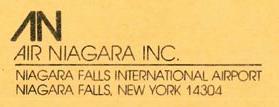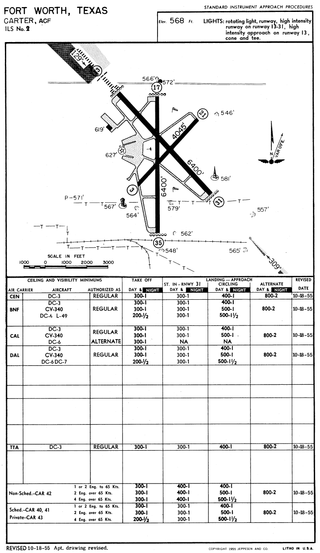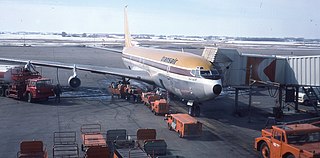Jack Brooks Regional Airport, formerly Southeast Texas Regional Airport, is near Port Arthur, Texas, nine miles (14 km) southeast of Beaumont and northeast of Port Arthur. It was Jefferson County Airport, but its name was changed to honor former U.S. Representative Jack Brooks. The airport is southwest of the city of Nederland in unincorporated Jefferson County, and is used for general aviation. Southwest Airlines ended scheduled jet service in 1980 and several other airlines have started and ended service as well including American Eagle, Continental, Delta/Delta Connection and United Express. The latest chapter is the resumption of service by American Eagle for American Airlines to Dallas/Ft. Worth (DFW).

Air Niagara is a zeppelin blimp operator and formerly a scheduled passenger airline that previously operated jet aircraft based in the New York side of the Niagara Falls. It was one of the many airlines that started flying after the Airline Deregulation Act of 1978 in the United States. The company was acquired in early 2022 and is currently working on operating zeppelin tours.

Thunder Bay Airport is an airport in the city of Thunder Bay, Ontario, Canada. With 108,130 aircraft movements in 2012, it was the fourth busiest airport in Ontario and the 16th busiest airport in Canada. During the same year, more than 761,000 passengers went through the airport.

Nordair was a Quebec-based airline in Canada founded in 1947 from the merger of Boreal Airways and Mont Laurier Aviation.

Time Air was an airline in Canada founded in 1966 by businessman Walter “Stubb” Ross from Lethbridge in Alberta. It was called Lethbridge Air Service before becoming Time Airways Ltd. in 1969, which was later shortened to Time Air Ltd. In 1993 it was merged with Ontario Express to create Canadian Regional Airlines.
Inter-Canadien was a Canadian airline headquartered in Dorval, Quebec.

Great Lakes Airlines was a regional airline in Canada. It was formed in 1958 in Sarnia, Ontario by John Blunt and by 1983 became Air Ontario Ltd. In June 1987 Air Ontario Ltd. merged with Austin Airways to form Air Ontario Inc. which in turn subsequently operated Air Canada Connector code sharing passenger flights on behalf of Air Canada with Convair 580 and de Havilland Canada DHC-8 Dash 8 series 100 and 300 turboprops. Air Ontario also operated Fokker F28 Fellowship jets at one point.

Sault Ste. Marie Airport is an international airport located 8.0 nautical miles west-southwest of the city of Sault Ste. Marie, Ontario, Canada at the far eastern end of Lake Superior and the beginning of the St. Mary's River.

Erik Nielsen Whitehorse International Airport is an airport of entry located in Whitehorse, Yukon, Canada. It is part of the National Airports System, and is owned and operated by the Government of Yukon. The airport was renamed in honour of longtime Yukon Member of Parliament Erik Nielsen on December 15, 2008. The terminal handled 294,000 passengers in 2012, representing a 94% increase in passenger traffic since 2002. By 2017, this number had risen to 366,000. Air North is based in Whitehorse.

Summerside Airport is located 3.5 nautical miles north-northwest of Summerside, Prince Edward Island, Canada.

Fort Smith Regional Airport is a public use airport located near the Interstate 540 freeway three nautical miles (6 km) southeast of the central business district of Fort Smith, in Sebastian County, Arkansas, United States. FSM is governed by the Fort Smith Airport Commission as established by the City of Fort Smith, Arkansas. It serves the transportation needs of residents and businesses of western Arkansas and eastern Oklahoma. FSM is currently served by American Eagle, the regional airline affiliate of American Airlines. It has a large population of corporate and general aviation aircraft. A full-service fixed-base operator (FBO), Signature Flight Support, provides service to general aviation, airline, and military operators.

Quincy Regional Airport is a city-owned airport 12 miles east of Quincy, a city in Adams County, Illinois, United States. It is used for general aviation but also sees Southern Airways Express flights to Chicago's O'Hare International Airport and St. Louis Lambert International Airport, a service which is subsidized by the federal government's Essential Air Service program at a cost of $1,956,856. The Federal Aviation Administration (FAA) National Plan of Integrated Airport Systems for 2023–2027 categorized it as a national non-primary commercial service facility.

Greater Southwest International Airport, originally Amon Carter Field (ACF), was the commercial airport serving Fort Worth, Texas, from 1953 until 1974. Dallas/Fort Worth International Airport opened in 1974 a few miles north to replace Greater Southwest and Dallas Love Field as a single airport for the Dallas-Fort Worth Metroplex. The area is now a commercial/light-industrial park serving DFW International, centered along Amon Carter Boulevard, which follows the old north-south runway.

Norcanair was the name of a Canadian airline that existed from 1947 to 1987, and again briefly in the early 1990s and from 2001 to 2005.

Homer Airport is a state-owned public-use airport located two nautical miles (4 km) east of the central business district of Homer, a town in the Kenai Peninsula Borough of the U.S. state of Alaska.

Transair was an airline based in Canada. It was purchased by Pacific Western Airlines in 1979. Transair's operational headquarters was located at the Winnipeg International Airport in Manitoba.
Houma–Terrebonne Airport is a public airport located three miles (5 km) southeast of the central business district of Houma, a city in Terrebonne Parish, Louisiana, United States. It is owned by the Houma–Terrebonne Airport Commission.

Harry P. Williams Memorial Airport is a public airport located near the U.S. 90 highway outside of Patterson, Louisiana, United States with the airfield also serving Morgan City, Louisiana. It has two runways, one of them being water for seaplanes.
Talkeetna Airport is a state-owned public-use airport located one nautical mile (1.9 km) east of the central business district of Talkeetna, in the Matanuska-Susitna Borough of the U.S. state of Alaska.
Intair was a Canada-based airline that operated between 1989 and 1991.

















